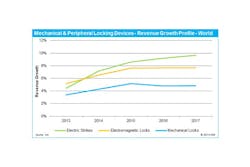According to a new report from IHS, revenues from the sale of electric strikes and electromagnetic locks are expected to outpace those of mechanical locks through 2017.
In fact, the market research firm is forecasting that from 2012 to 2017, global revenues for electromagnetic locks and electric strikes will grow at a compound annual growth rate (CAGRs) of 6.9 percent and 7.8 percent respectively, compared to mechanical locks which are expected to grow at a CAGR of 4.5 percent during the same time frame.
Adi Pavlovic, analyst for access control, fire and security at IHS, attributes the increased demand for electric locks to the rise in popularity of electronic access control systems.
“Access control systems are becoming increasingly popular because they provide a higher level of security while offering integration opportunities with time management and building automation systems. While the main barrier for growth of electronic access control is higher upfront cost, the long term benefits involve reduction in costs associated with rekeying mechanical cylinders,” wrote Pavlovic in a research note.
Despite this trend, however, IHS doesn’t believe that mechanical locks are being completely replaced and indicated that most applications will still require a mechanical lock in the case of a power failure or system error. Therefore, Pavlovic said that the growth of access control systems is only “limiting” the growth of mechanical solutions in the medium-term.
“This trend towards electric locking solutions is not only impacting mechanical locks, but exit devices as well. Globally, standard mechanical exit devices were estimated by IHS to account for 70.8 percent of all exit device revenues in 2012. This number is projected to decline to 69.8 percent by 2017 due to the increased adoption of electrified trim and electrified latch retraction exit devices. Solutions that implement electric locking devices as a means of security will commonly install electric exit devices for egress in order to fulfill a complete access control system,” continued Pavlovic.
“Overall, the trend towards electric locking solutions is active on a global level. While growth for mechanical locks is expected to be somewhat limited due to this trend, the global mechanical locks market is still projected to have healthy growth in the medium-term. In terms of revenue, when comparing the markets for exit devices, mechanical locks and electric locks (strikes and electromagnetic), IHS estimates that about 77 percent were mechanical in 2012. By 2017, IHS expects the market for mechanical solutions to represent only 71 percent.”






